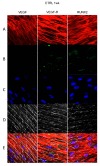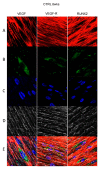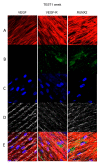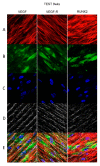VEGF/VEGF-R/RUNX2 Upregulation in Human Periodontal Ligament Stem Cells Seeded on Dual Acid Etched Titanium Disk
- PMID: 32033260
- PMCID: PMC7040902
- DOI: 10.3390/ma13030706
VEGF/VEGF-R/RUNX2 Upregulation in Human Periodontal Ligament Stem Cells Seeded on Dual Acid Etched Titanium Disk
Abstract
In restorative dentistry, the main implants characteristic is the ability to promote the osseointegration process as the result of interaction between angiogenesis and osteogenesis events. On the other hand, implants cytocompatibility remains a necessary feature for the success of surgery. The purpose of the current study was to investigate the interaction between human periodontal stem cells and two different types of titanium surfaces, to verify their cytocompatibility and cell adhesion ability, and to detect osteogenic and angiogenic markers, trough cell viability assay (MTT), Confocal Laser Scanning Microscopy (CLSM), scanning electron microscopy (SEM), and gene expression (RT-PCR). The titanium surfaces, machined (CTRL) and dual acid etched (TEST), tested in culture with human periodontal ligament stem cells (hPDLSCs), were previously treated in two different ways, in order to evaluate the effects of CTRL and TEST and define the best implant surface. Furthermore, the average surface roughness (Ra) of both titanium surfaces, CTRL and TEST, has been assessed through atomic force microscopy (AFM). The vascular endothelial growth factor (VEGF) and Runt-related transcription factor 2 (RUNX2) expressions have been analyzed by RT-PCR, WB analysis, and confocal laser scanning microscopy. Data evidenced that the different morphology and topography of the TEST disk increased cell growth, cell adhesion, improved osteogenic and angiogenic events, as well osseointegration process. For this reason, the TEST surface was more biocompatible than the CTRL disk surface.
Keywords: angiogenesis; cytocompatibility; osseointegration; osteogenesis.
Conflict of interest statement
The authors declare no conflict of interest.
Figures








Similar articles
-
Enhanced VEGF/VEGF-R and RUNX2 Expression in Human Periodontal Ligament Stem Cells Cultured on Sandblasted/Etched Titanium Disk.Front Cell Dev Biol. 2020 May 14;8:315. doi: 10.3389/fcell.2020.00315. eCollection 2020. Front Cell Dev Biol. 2020. PMID: 32478069 Free PMC article.
-
Human Periodontal Ligament Stem Cells Response to Titanium Implant Surface: Extracellular Matrix Deposition.Biology (Basel). 2021 Sep 18;10(9):931. doi: 10.3390/biology10090931. Biology (Basel). 2021. PMID: 34571808 Free PMC article.
-
Infrared diode laser enhances human periodontal ligament stem cells behaviour on titanium dental implants.Sci Rep. 2024 Feb 20;14(1):4155. doi: 10.1038/s41598-024-54585-w. Sci Rep. 2024. PMID: 38378776 Free PMC article.
-
MicroRNA 210 Mediates VEGF Upregulation in Human Periodontal Ligament Stem Cells Cultured on 3DHydroxyapatite Ceramic Scaffold.Int J Mol Sci. 2018 Dec 6;19(12):3916. doi: 10.3390/ijms19123916. Int J Mol Sci. 2018. PMID: 30563289 Free PMC article.
-
[The role of surface roughness in promoting osteointegration].Refuat Hapeh Vehashinayim (1993). 2003 Jul;20(3):8-19, 98. Refuat Hapeh Vehashinayim (1993). 2003. PMID: 14515625 Review. Hebrew.
Cited by
-
Effect of Puerarin on Osteogenic Differentiation in vitro and on New Bone Formation in vivo.Drug Des Devel Ther. 2022 Aug 27;16:2885-2900. doi: 10.2147/DDDT.S379794. eCollection 2022. Drug Des Devel Ther. 2022. PMID: 36060929 Free PMC article.
-
Bone Regeneration and Oxidative Stress: An Updated Overview.Antioxidants (Basel). 2022 Feb 6;11(2):318. doi: 10.3390/antiox11020318. Antioxidants (Basel). 2022. PMID: 35204201 Free PMC article. Review.
-
Improved osteogenic differentiation by extremely low electromagnetic field exposure: possible application for bone engineering.Histochem Cell Biol. 2022 Oct;158(4):369-381. doi: 10.1007/s00418-022-02126-9. Epub 2022 Jun 25. Histochem Cell Biol. 2022. PMID: 35751679 Free PMC article.
-
Biological Effects of PMMA and Composite Resins on Human Gingival Fibroblasts: An In Vitro Comparative Study.Int J Mol Sci. 2024 Apr 30;25(9):4880. doi: 10.3390/ijms25094880. Int J Mol Sci. 2024. PMID: 38732100 Free PMC article.
-
Dental Pulp Stem Cells on Implant Surface: An In Vitro Study.Biomed Res Int. 2021 Mar 23;2021:3582342. doi: 10.1155/2021/3582342. eCollection 2021. Biomed Res Int. 2021. PMID: 33834063 Free PMC article.
References
-
- Rajan T.S., Scionti D., Diomede F., Grassi G., Pollastro F., Piattelli A., Cocco L., Bramanti P., Mazzon E., Trubiani O. Gingival Stromal Cells as an In Vitro Model: Cannabidiol Modulates Genes Linked With Amyotrophic Lateral Sclerosis. J. Cell. Biochem. 2017;118:819–828. doi: 10.1002/jcb.25757. - DOI - PubMed
-
- Di Nisio C., De Colli M., di Giacomo V., Rapino M., Di Valerio V., Marconi G.D., Gallorini M., Di Giulio M., Cataldi A., Zara S. A dual role for beta1 integrin in an in vitro Streptococcus mitis/human gingival fibroblasts co-culture model in response to TEGDMA. Int. Endod. J. 2015;48:839–849. doi: 10.1111/iej.12379. - DOI - PubMed
LinkOut - more resources
Full Text Sources
Miscellaneous

